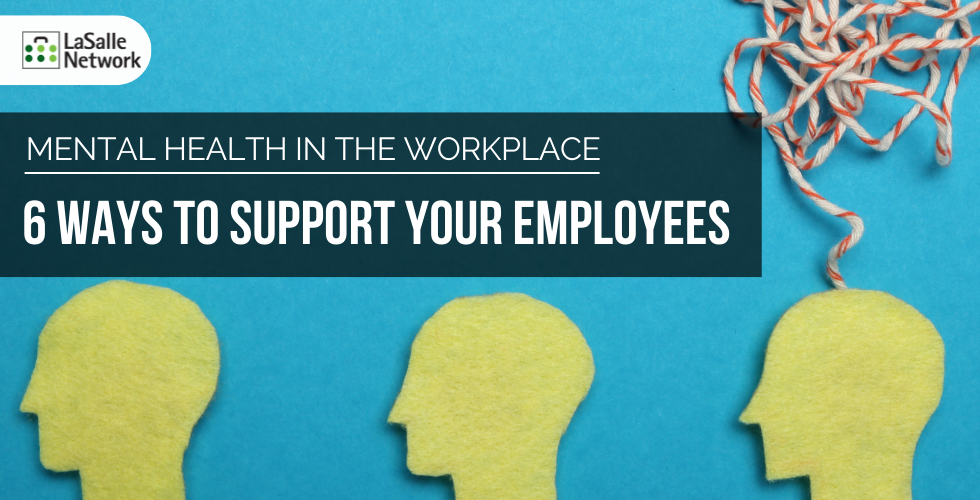Emotional intelligence and displaying empathy for employees, especially during times of stress, is an important aspect of creating a strong company culture. Every company culture is different, and whether or not it is appropriate to directly address any personal, political or social tensions faced, it is important leaders conduct wellness checks to both gauge employee stress levels and offer support.
Below, we share 6 essential steps for an effective wellness check.
Start at the Top
While training managers to perform effective wellness checks, it is important to first check in with management themselves to gauge their mental health and assess if they are ready and able to reach out to support others. Wellness checks need to start from the top and be continued at every level of the organization to ensure each person is receiving regular touch points. If managers begin performing wellness checks when they themselves are struggling, this may add unwarranted stress and result in burnout. HR should continue to perform their own wellness checks with management regularly.
Skip Email
Make in-person conversations or video calls the norm. While it takes an investment of time, talking live over chatting or emailing with employees is what sets great leaders apart. To know how people are doing, you need to look into their eyes. This means closing other tabs on your screen or silencing notifications while meeting.
Even before an employee expresses struggle, make it known what mental health resources are available to them. This should include education on benefits that support mental health, such as teletherapy, and include third-party recourses, such as the Calm meditation app or a list of good self-help books. Provide management with a regularly updated list of resources that they can recommend during wellness checks.
Ask the Right Questions
Especially if wellness checks are not an already established part of an organization’s employer/employee communication, it is important to take steps to ensure that the conversations feel authentic and genuine. Employees are not likely to disclose emotional challenges or be truthful about their engagement level if they feel the information could be used against them or like their manager doesn’t genuinely care. In order to make wellness check-ins as natural as possible, management should lead with vulnerability and empathy, setting the precedent for open conversations.
Notice the Nonverbals
Emotion is often communicated nonverbally, emitted through tone of voice and facial expressions rather than words alone. There are several important nonverbal cues to take note of. Notice if someone seems to want to say something but doesn’t want to interrupt you. Notice if their expression or body language seem to contradict what they are saying, for example saying “I’m doing well” with a straight face or frown. Also notice if they are repeatedly shifting their gaze, which can be a sign of discomfort.
Address what you are seeing in a non-accusatory way, acknowledging that your understanding might be limited. By saying something along the lines of “from what I can see of your expression, you seemed like maybe there was something going on, so I wanted to check in,” you can give them an opportunity to share.
Integrate Other Teams
Depending on the organization and team, it may be appropriate for employees to have leaders they do not directly report to reaching out to conduct occasional wellness checks. This may include a manager two layers above, a member of HR, or a more tenured peer the employee has an established relationship with. Having another person to connect with beyond a manager may help to ease tensions and create a dialogue, especially if the employee does not want to disclose certain concerns directly to their boss.
It can also be helpful to create wellness initiatives on the peer-to-peer level. Consider doing a “Wellness Wednesday” or weekly tradition for members of one team to reach out to members of another team simply to see how the other is doing. This not only can be beneficial to the employees’ mental health but can also serve as a culture-building event to keep hybrid teams connected.
Use an Employee Assistance Program (EAP)
Wellness checks serve as a tool to improve relationships and create a support system but are not a replacement for mental health services. Use wellness checks to identify an employee’s stress level and take note of who might need more frequent check ins or an EAP. EAPs are designed to assist employees in resolving personal problems like issues like alcohol or substance abuse, child or elder care, relationship challenges, financial or legal problems, wellness matters and traumatic events. EAP services are also usually made available to the employee’s spouse and children, if needed.
How businesses respond to mental health will have a lasting impact on employee behavior including engagement, productivity and loyalty. Employers have the unique opportunity to help employees address mental wellbeing and integrate work and personal lives in a meaningful way.
If you’re looking for skilled leaders to help lead the charge in supporting employee wellness, we can help. Get connected here.




